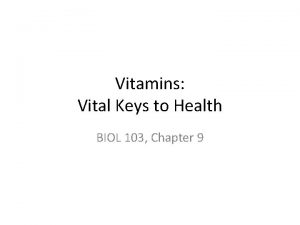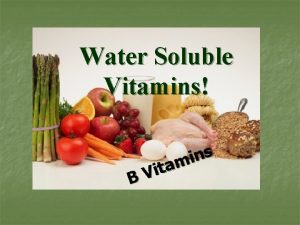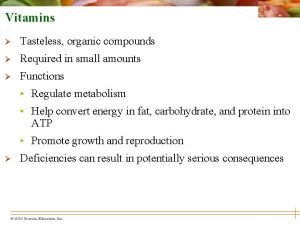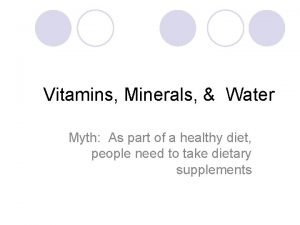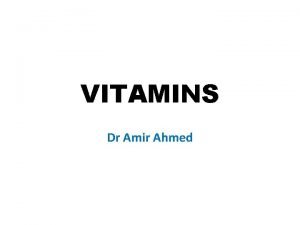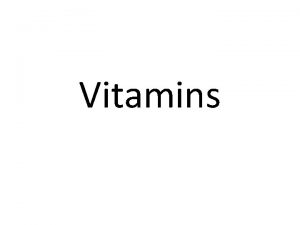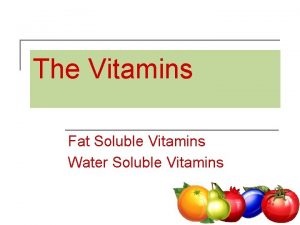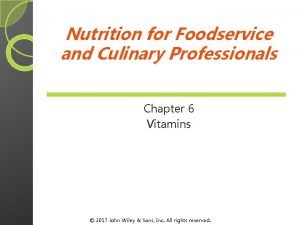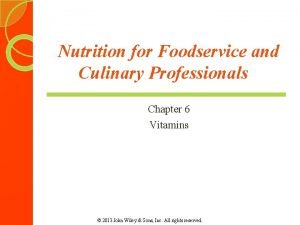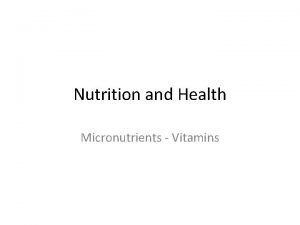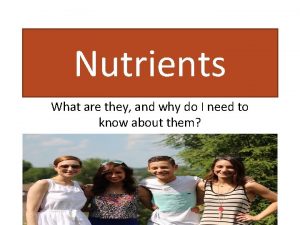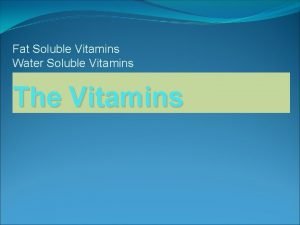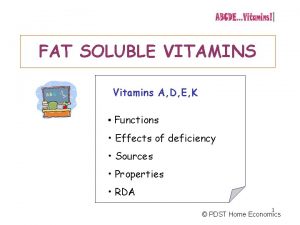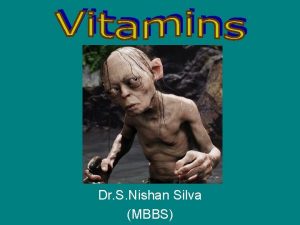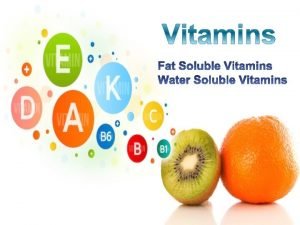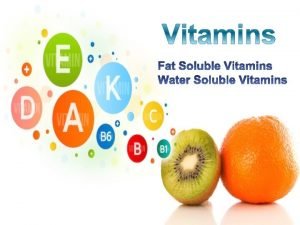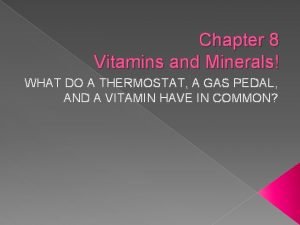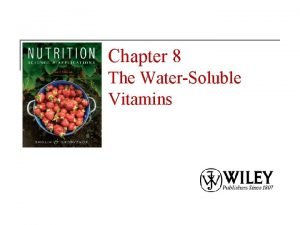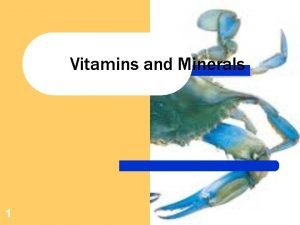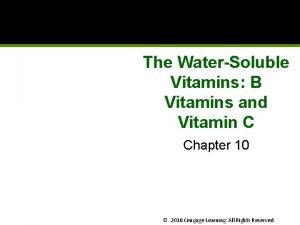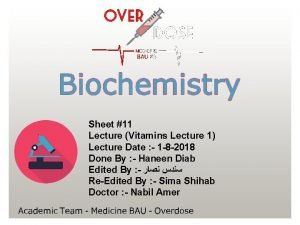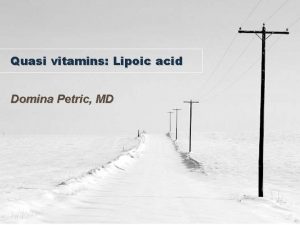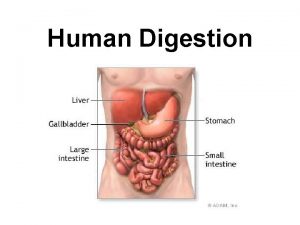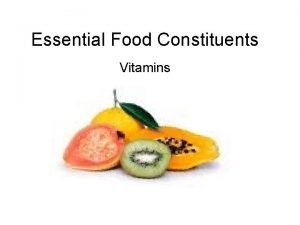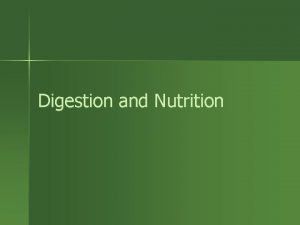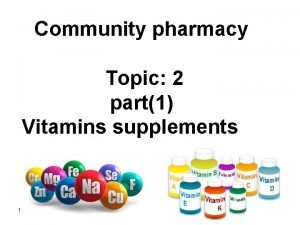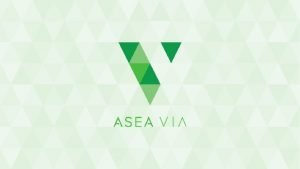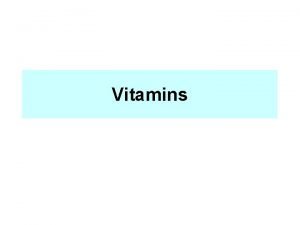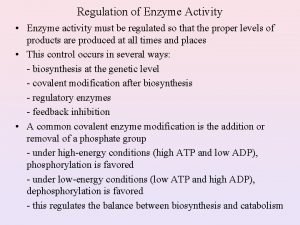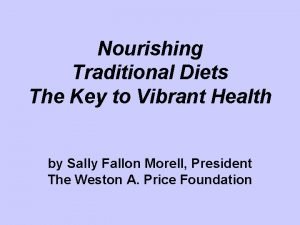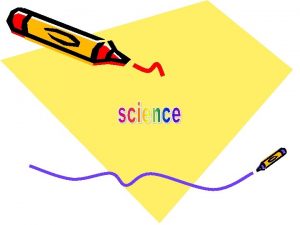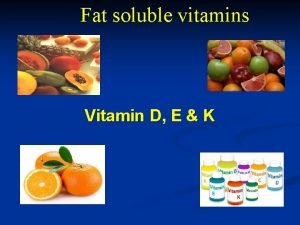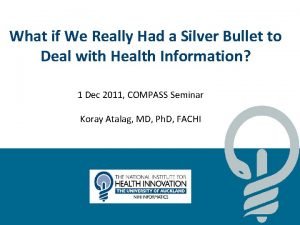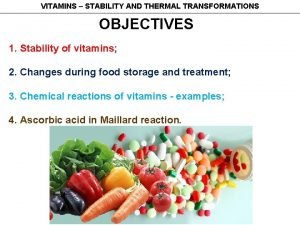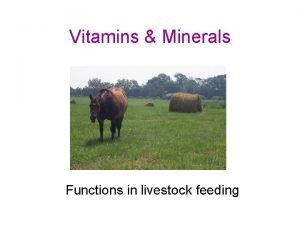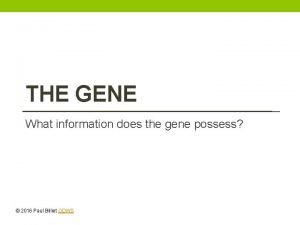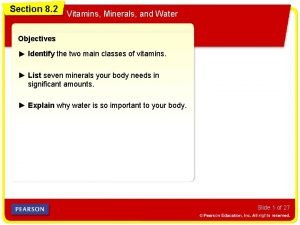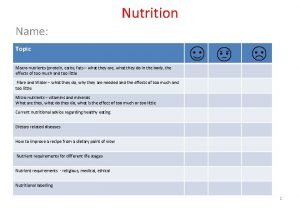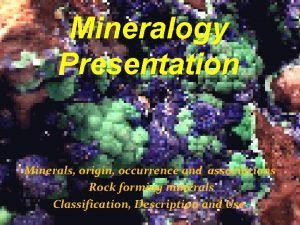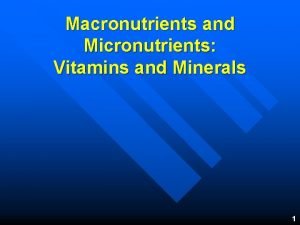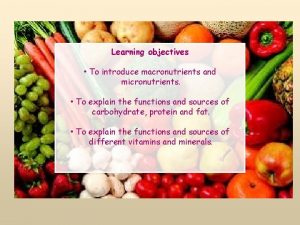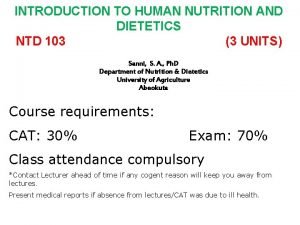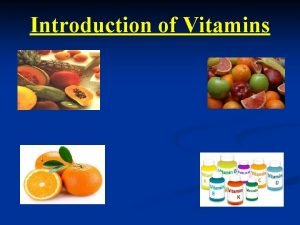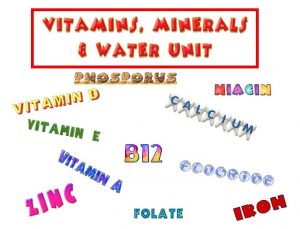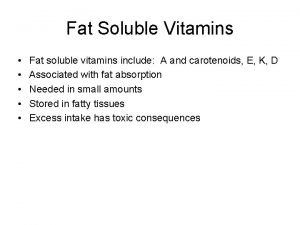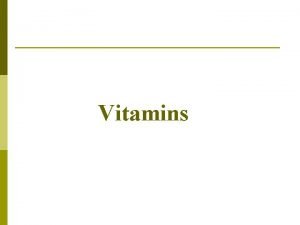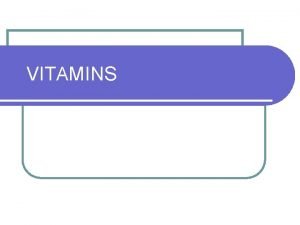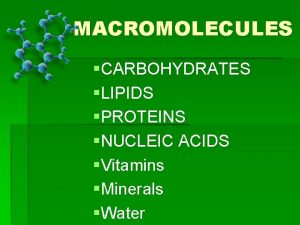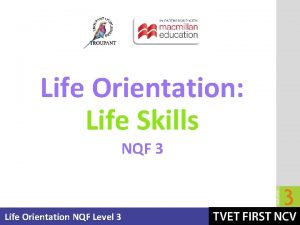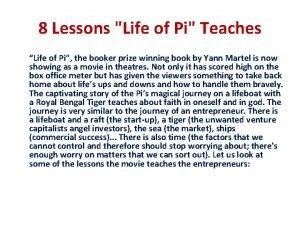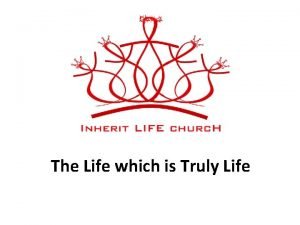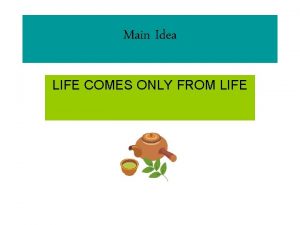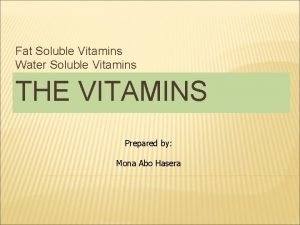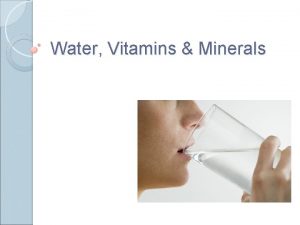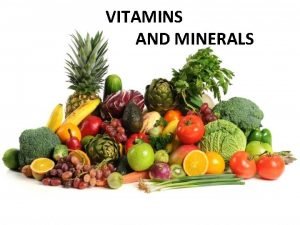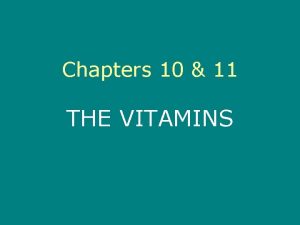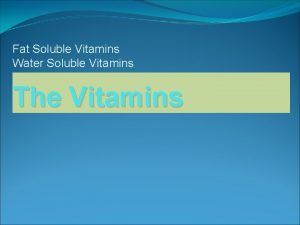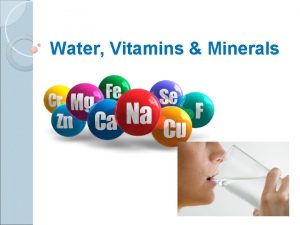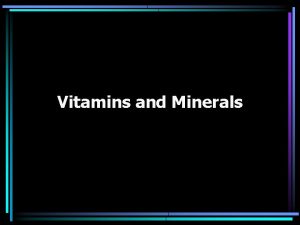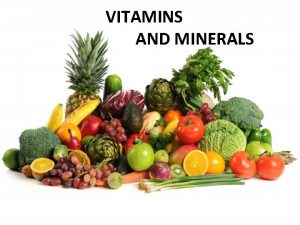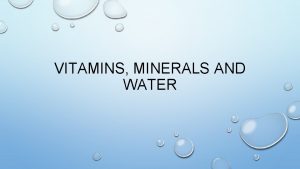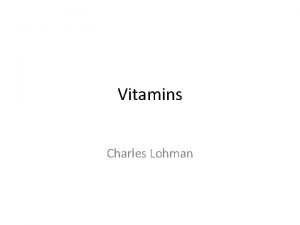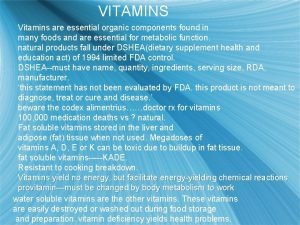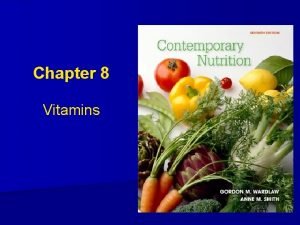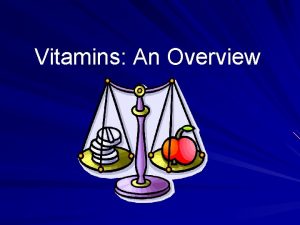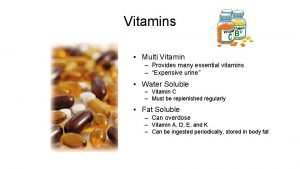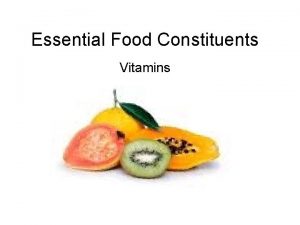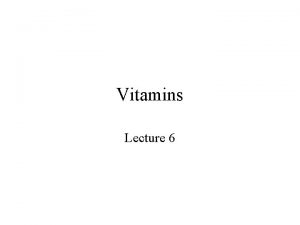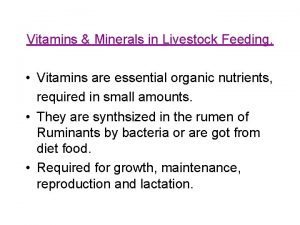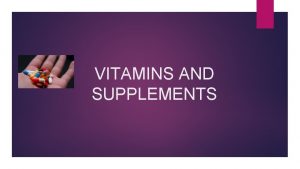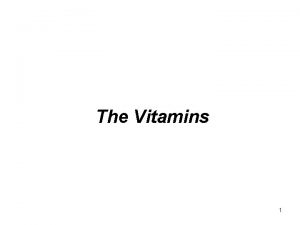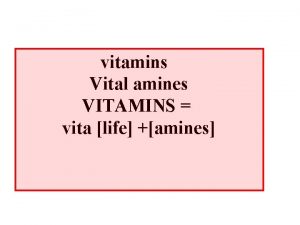VITAMINS VITAMINS Vitamins are essential to life Vitamins






































































- Slides: 70

VITAMINS

VITAMINS Vitamins are essential to life Vitamins are required for: Growth Maintenance Regulation of body processes

VITAMINS Vitamins do not supply energy However, some vitamins do function as coenzymes in the release of energy from carbohydrates, proteins and fats Some vitamins available from foods in inactive forms known as precursors Once inside the body, precursors are converted into an active form of the vitamin

VITAMINS Because vitamins are organic, they can be destroyed and left unable to function Heat – keep refrigerated, don’t over cook Light (ultraviolet) – store in opaque containers Oxygen – after cut, keep airtight Some water soluble – cook with less water The body needs vitamins in small amounts Milligrams (mg) or micrograms (µg) instead of grams (g) Although needed in small amounts, vitamins are needed on a regular basis.

VITAMINS 13 different vitamins, each with its own roles Vitamins grouped into two major categories: Fat-soluble (4 fat soluble) �Vitamin A �Vitamin D �Vitamin E �Vitamin K

VITAMINS Water-soluble (9 water soluble: 8 B vitamins & C) �Thiamin �Riboflavin �Niacin �Biotin �Pantothenic acid �Vitamin B 6 �Folate �Vitamin B 12 �Vitamin C

VITAMINS Fat-soluble vitamins �Found in fats and oils of foods �After absorbed enter lymph, then blood �Protein carriers for transport �Stored (fatty tissue/liver) �Doesn’t need as regularly - weekly, monthly; because stored �Deficiencies slow to develop; because stored �Toxicities more likely; because stored (mostly from supplements) �Precursors �Fecal excretion

VITAMINS Water-soluble vitamins �Found in watery parts of foods �After absorbed move directly into blood �Transported freely in blood �Not stored �Needed more regularly – every 1 -3 days; because not stored �Deficiencies fast to develop; because not stored �Toxicities less likely (large amounts can overwhelm) �Usually no precursors �Urine excretion

VITAMINS Consuming vitamins in the right amount is important Inadequate amounts can cause harm and excessive amounts can cause harm �More is not better The fact a compound can be essential and harmful is true of most nutrients

FAT SOLUBLE VITAMINS

Vitamin A Other Names Retinol Retinal Retinoic acid Precursors are carotenoids such as beta- carotene

Vitamin A Functions Vision Maintenance of cornea, epithelial cells, mucous membranes, skin Bone and tooth growth Reproduction Immunity.

Vitamin A Food Source Retinol: fortified milk, cheese, cream, butter, fortified margarine, eggs, liver. Beta-carotene: spinach and other dark leafy greens; broccoli, deep orange fruits (apricots, cantaloupe) and vegetables (squash, carrots, sweet potatoes, pumpkin)


Vitamin D Other Names Calciferol, 1, 25 -dihydroxy vitamin D (calcitriol) The animal version is vitamin D 3 or cholecalciferol The plant version is vitamin D 2 or ergocalciferol Body cholesterol is a precursor

Vitamin D Functions Mineralization of bones (raises blood calcium and phosphorus by increasing absorption from digestive tract, withdrawing calcium from bones, stimulating retention by kidneys)

Vitamin D Food Sources Synthesized in the body with the help of sunlight Fortified milk, margarine, butter, cereals and chocolate mixes Egg yolk, meat, liver, fatty fish (herring, salmon, sardines) and their oils


Vitamin D Deficiency Diseases Rickets Osteomalacia

Vitamin D Rickets in Children Deficiency Symptoms Inadequate calcification, resulting in misshapen bones (bowing of legs) Enlargement of ends of long bones (knees, wrists) Deformities of ribs (bowed, with beads or knobs) Delayed closing of fontanel, resulting in rapid enlargement of head Lax muscles resulting in protrusion of abdomen Muscle spasms

Vitamin D Osteomalacia in Adults Deficiency Symptoms Loss of calcium resulting in soft, flexible, brittle, and deformed bones Progressive weakness Pain in pelvis, lower back and legs

Vitamin D Toxicity Disease Hypervitaminosis D Toxicity Symptoms Elevated blood calcium Calcification of soft tissues (blood vessels, kidneys, heart, lungs, tissues around joints) Frequent urination

WATER SOLUBLE VITAMINS

Vitamin C Functions Collagen synthesis (strengthens blood vessels walls, forms scar tissue, provides matrix for bone growth) Antioxidant Thyroxin synthesis Amino acid metabolism Strengthens resistance to infection Helps in absorption of iron


Vitamin C Food Sources Citrus fruits (oranges, grapefruits, tangerines, lemons, limes). Cabbage-type vegetables; Dark green vegetables (such as bell peppers and broccoli) Strawberries and other berries, cantaloupe and other melons, papayas, mangoes, potatoes, and tomatoes Destruction Easily destroyed by heat and oxygen

Vitamin C Deficiency Disease Scurvy Deficiency Symptoms Anemia, atherosclerotic plaques, pinpoint hemorrhages Bone fragility, joint pain Poor wound healing, frequent infections Bleeding gums, loosened teeth Muscle degeneration and pain Hysteria, depression Rough skin, blotchy bruises

Vitamin C Toxicity Symptoms Nausea, abdominal cramps, diarrhea Headache, fatigue, insomnia Hot flashed, rashes Interference with medical tests Aggravation of gout symptoms Urinary tract problems, kidney stones

Thiamin Function Part of coenzyme TPP (thiamin pyrophosphate) used in energy metabolism Food Sources Whole-grain, fortified, or enriched grain products Moderate amounts in all nutritious food Pork Destruction Easily destroyed by heat


Thiamin Deficiency Disease Beriberi (wet with edema; dry with muscle wasting) Deficiency Symptoms Enlarged heart, cardiac failure Muscular weakness Apathy, poor short-term memory, confusion, irritability Anorexia, weight loss Toxicity Symptoms None reported

Riboflavin Function Part of coenzymes FMN (flavin mononucleotide) and FAD (flavin adenine dinucleotide) used in energy metabolism


Riboflavin Food Sources Milk and dairy products (yogurt, cheese). Enriched or whole grains Liver Destruction Easily destroyed by ultraviolet light and irradiation

Niacin Functions Part of coenzymes NAD (nicotinamide adenine dinucleotide) and NADP (its phosphate form) used in energy metabolism


Niacin Food Sources Milk, eggs, meat, poultry, fish Whole-grain and enriched breads and cereals Nuts All protein-containing foods

Niacin Deficiency Disease Ariboflavinosis Deficiency Symptoms Sore throat Cracks and redness at corners of mouth (cheilosis) Painful smooth, purplish red tongue (glossitis) Inflammation characterized by skin lesions covered with greasy scales

Niacin Toxicity Symptoms Painful flush, hives, and rash (niacin flush) Nausea, vomiting Liver damage Impaired glucose tolerance

Minerals

Why Minerals? Important for normal metabolism Found in tissues and fluids in the body Macro and micro



Mineral Functions Minerals work together to perform important functions in the body Fluid and electrolyte balance Blood formation Building healthy bones Maintaining a healthy immune system

Minerals Help Maintain Fluid Balance Minerals play a key role in fluid balance in the cells Extracellular minerals – sodium and chloride Intracellular mineral – potassium with the help of calcium, magnesium, and sulfur

Mineral Participate as Cofactors Cofactor – substance that helps catalyze a reaction Minerals serve as cofactors in Antioxidant systems Energy production Muscle contraction Nerve transmission

Minerals Make Up Bones and Teeth Minerals make up the crystalline structure (hydroxyapatite) that gives strength to bones and teeth Major minerals �Calcium, phosphorus, and magnesium Trace mineral �Flouride

Minerals Can Be Toxic If ingested in high amounts, minerals can be toxic; however, mineral toxicity is rare Toxicity most often seen with Large amounts of supplements Certain conditions that interfere with the body’s adaptive abilities Toxicity not generally seen from excess dietary intake


Calcium Important for structure of bones and teeth Has a role in muscle contraction and blood clotting Sources: Milk and milk products, fortified orange juice, sardines Adequate Intake is 1, 000 milligrams for people between 19 -50 years old

SOURCES OF CALCIUM

Osteoporosis Common bone disease Bone tissue becomes weak and porous Prevention requires exercise and adequate consumption of calcium and vitamin D




Potassium One of the electrolytes Balance charges and water concentration across cells Food Sources: Avocados, bananas, potatoes, dairy products


Sodium Signal transmission between nerves Muscle contraction Sources: Table salt, processed foods, nuts and snacks





Iron Part of heme which carries oxygen in blood Iron deficiency anemia causes tiredness


Heme and Non heme iron Heme iron is easily absorbed Meat, fish, poultry Nonheme iron poorly absorbed Dark leafy vegetables, beans, fortified cereals Non heme iron absorption inhibited by coffee, tea, high fiber foods Non heme iron absorption increased by orange juice


IODINE



Conclusion Minerals are essential for health RDAs can usually be met with the minerals present in food Vary the types of vegetables, whole grains, dairy, and protein that you consume to ensure meeting your needs
 Insidan region jh
Insidan region jh Water soluble vitamins vs fat soluble vitamins
Water soluble vitamins vs fat soluble vitamins Essential non essential fatty acids
Essential non essential fatty acids 25 elements essential to life
25 elements essential to life Water soluble vitamins characteristics
Water soluble vitamins characteristics Water soluble vitamins absorption
Water soluble vitamins absorption Function of minerals
Function of minerals How are water-soluble vitamins absorbed
How are water-soluble vitamins absorbed Are vitamins organic compounds
Are vitamins organic compounds Vital amines vitamins
Vital amines vitamins Manaquinone
Manaquinone Kellogg's pep vitamins advertisement analysis
Kellogg's pep vitamins advertisement analysis Categories of vitamins
Categories of vitamins Categories of vitamins
Categories of vitamins Vitamins functions
Vitamins functions Vitamin a foods examples
Vitamin a foods examples List of macronutrients and micronutrients
List of macronutrients and micronutrients Water soluble vitamins characteristics
Water soluble vitamins characteristics Adek vitamins fat soluble
Adek vitamins fat soluble Echymosis
Echymosis Water soluble vitamins characteristics
Water soluble vitamins characteristics Characteristics of water soluble vitamins
Characteristics of water soluble vitamins Chapter 8 vitamins and minerals
Chapter 8 vitamins and minerals Which statement concerning vitamins is incorrect?
Which statement concerning vitamins is incorrect? Carrotinoids
Carrotinoids Excess b vitamins urine
Excess b vitamins urine Vitamins definition
Vitamins definition Petric acid
Petric acid Types of vitamins
Types of vitamins Importance of vitamins
Importance of vitamins Characteristics of water soluble vitamins
Characteristics of water soluble vitamins Vitamins part1
Vitamins part1 Asea via source ingredients
Asea via source ingredients Do vitamins yield energy
Do vitamins yield energy Thiamin
Thiamin Hemoragea
Hemoragea Primitiv vitamins
Primitiv vitamins Food pyramid carbohydrates fats proteins vitamins minerals
Food pyramid carbohydrates fats proteins vitamins minerals Water soluble vitamins
Water soluble vitamins Water soluble vitamins
Water soluble vitamins Every 8 hours medication times
Every 8 hours medication times Objectives of vitamins
Objectives of vitamins Conclusion of vitamins
Conclusion of vitamins Classification of vitamins chart
Classification of vitamins chart Neurospora crassa
Neurospora crassa Objectives of vitamins
Objectives of vitamins Vitamin deficiency diseases chart
Vitamin deficiency diseases chart Kyanite formula
Kyanite formula Vitamins type
Vitamins type Objectives of vitamins
Objectives of vitamins Ntd nutrition
Ntd nutrition Types of vitamins
Types of vitamins Water soluble vitamins chart
Water soluble vitamins chart Digestion vitamins
Digestion vitamins Celiac beri beri
Celiac beri beri Vitamins definition and classification
Vitamins definition and classification Are vitamins and minerals macromolecules
Are vitamins and minerals macromolecules City and country life vocabulary
City and country life vocabulary Farm life vs city life
Farm life vs city life What do you use polynomials for in real life
What do you use polynomials for in real life Benefits of arranged marriage
Benefits of arranged marriage Difference between life skills and life orientation
Difference between life skills and life orientation Country life vs city life compare /contrast
Country life vs city life compare /contrast City life vs country life
City life vs country life Lesson in life of pi
Lesson in life of pi Boundaries meme
Boundaries meme Life that is truly life
Life that is truly life The idea life comes from life is
The idea life comes from life is Unit 8 country life and city life
Unit 8 country life and city life Westward expansion discussion questions
Westward expansion discussion questions Essential clothing limited
Essential clothing limited

